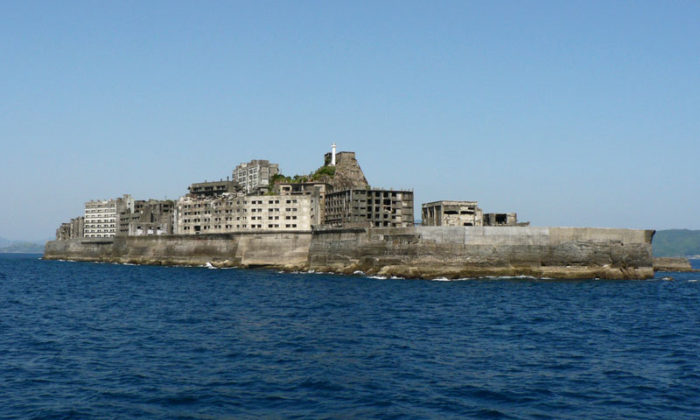Published in the Nikkei Asian Review 14/4/2016
James Bond never had to wait for a cancellation on a sight-seeing boat, but I did. Our destination was the same – Hashima, a tiny island off Nagasaki which once housed a thriving mining town.
This bizarre ruin – also known as Gunkanjima, or ”Battleship Island” on account of its shape – was the inspiration for the villain’s lair in the 007 movie Skyfall. Last year it was listed as a UNESCO World Heritage site, making it a popular destination in the new genre of “industrial tourism.”
Bond traveled by speedboat in the company of a glamorous female agent. Unlike me, he did not have to contend with hordes of tourists hell-bent on reaching the island on the very same day. You see, a cruise ship had arrived overnight from Shanghai and docked a couple of hundred yards from my hotel.
The Italian-owned Costa Serena is not so much a boat as a floating city, with twelve decks that give her the height of a 23-storey building, a spa the size of a football pitch and a cargo of 3,700 souls, all determined to maximize their brief Nagasaki experience. By the next day it had gone, to be replaced by another craft of the same type.
To say the tourist industry of Nagasaki – the historic port city on Japan’s southwestern island of Kyushu – is booming would be an understatement. Yet if government targets are any guide to the future, this is only the beginning. Visitor arrivals to Japan have already soared from 5 million in the year 2000 to 19.7 million in 2015. Now the government has doubled its official target to 40 million by 2020 and 60 million by 2030.
If these goals are realised, Japan will become a top-ranking tourist destination, up there with France and Italy. That implies vast increases in hotel capacity, shopping splurges at favoured retailers and landings by ocean-going behemoths like the Serena. It also implies drastic change in Japan’s perception of the world and the world’s perception of Japan.
World-wide mass tourism is a new phenomenon. As recently as 1960, global tourist numbers totalled just 69 million, nearly all of whom were white and wealthy. Last year the number was 1.2 billion, equivalent to almost one sixth of the human race, and the number of mainland Chinese tourists alone reached 120 million. The standard image of a tourist has changed from a middle-aged American with an expensive camera resting on his stomach to young Asians wielding selfie-sticks.
The World Tourism Authority claims that global tourism receipts (including transportation fees) are equivalent to 6% of world exports of goods and services – which puts the industry on a level with autos and foods. No country can afford to ignore such a bonanza. Yet culture shock is inevitable.
So far the Japanese media has responded with good humour to such phenomena as foreign visitors clambering into cherry trees during the blossom-viewing season. But how will people react when they find their favourite sushi places filled with foreigners squirting ketchup on the maguro and arguing about the bill? Or their romantic interludes at hot-springs resort being interrupted by tour groups shampooing themselves in the rotenburo outdoor baths?
The paradox of tourism is that it destroys the cultural specificity that is its own raison d’être. Once everywhere becomes like everywhere else, with the same international hotels and coffee shops and souvenir T-shirts, then you might as well stay at home. Already the ancient centres of many European cities have become soulless wastelands of milling crowds and rip-offs where no local would venture for pleasure. Until recently Japan has been insulated from mass tourism by barriers of cost, language and geography. No longer. Regardless of government targets, the tourists are coming.
An alternative, distinctly Japanese approach would be to take a tip from historical Nagasaki. Throughout the Edo period (1603-1868), when Japan was largely closed off from the world, Dutch merchants were allowed to maintain a trading post on Dejima, an artificial island in Nagasaki Bay built for the purpose.
Imagine a string of high-tech Dejima equivalents today. They would be off-shore resorts, complete with casinos and golf-courses and shopping malls stuffed with luxury retailers. Fully interactive experience of Japan’s cultural treasures would be provided via virtual reality headsets.
In many ways it could be better than the real thing. After all James Bond himself never set foot on Battleship Island – ironically it was deemed too dangerous for filming. In the end the sequences were mocked up in the studio.


